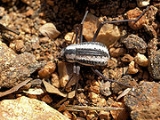
Namib Desert beetle
Encyclopedia
The Namib Desert beetle
dwells in one of the most arid areas with only one and half inch (40 mm) of rain per year, and has developed a unique technique to survive by obtaining water from early morning fogs. It drinks by the means of its own bumpy back surface, which provides for accumulation of water droplets of fifteen to twenty micrometers
in diameter.The beetle has long spindely legs.
To drink water, the Namib beetle (genus Stenocara) stands on a small ridge of sand. Facing into the breeze, with its body angled at forty-five degrees, the beetle catches fog droplets on its hardened wings. Its head faces upwind, and its stiff, bumpy outer wings are spread against the damp breeze. Minute water droplets from the fog gather on its wings; there the droplets stick to hydrophilic bumps, which are surrounded by waxy, hydrophobic troughs. Droplets accumulate and coalesce until their combined weight overcomes the water's electrostatic attraction to the bumps as well as any opposing force of the wind; in a ten-mile-an-hour breeze, such a droplet would stick to the wing until it grows to roughly two-tenths of an inch in diameter; at that point it would roll down the beetle's back to its mouth parts.
The water droplets in fog are, on average, just one one-thousandth of an inch across, and the largest ones are only twice that size. The droplets are so small, in fact, that they often don't fall downward; instead they get carried sideways or even upward by currents of wind.The trick to drinking fog is getting the droplets to aggregate, so that wind and electrostatic forces no longer overwhelm gravity. When a wind-blown fog droplet lands on a hydrophilic (water-loving) surface, such as clean glass or stone, the drop flattens out because of the electrostatic attraction between the molecules of water and those of the surface. The cross section of the flat drop is too small for the wind to pick it back up. And, because water molecules so strongly attract each other, the flat drop also presents a highly hydrophilic surface to which other droplets can attach.
Researchers at the Massachusetts Institute of Technology
have emulated this capability by creating a textured surface that combines alternating hydrophobic and hydrophilic materials. Potential uses include extracting moisture from the air and creating fog-free windows and mirrors.
Beetle
Coleoptera is an order of insects commonly called beetles. The word "coleoptera" is from the Greek , koleos, "sheath"; and , pteron, "wing", thus "sheathed wing". Coleoptera contains more species than any other order, constituting almost 25% of all known life-forms...
dwells in one of the most arid areas with only one and half inch (40 mm) of rain per year, and has developed a unique technique to survive by obtaining water from early morning fogs. It drinks by the means of its own bumpy back surface, which provides for accumulation of water droplets of fifteen to twenty micrometers
Micrometre
A micrometer , is by definition 1×10-6 of a meter .In plain English, it means one-millionth of a meter . Its unit symbol in the International System of Units is μm...
in diameter.The beetle has long spindely legs.
To drink water, the Namib beetle (genus Stenocara) stands on a small ridge of sand. Facing into the breeze, with its body angled at forty-five degrees, the beetle catches fog droplets on its hardened wings. Its head faces upwind, and its stiff, bumpy outer wings are spread against the damp breeze. Minute water droplets from the fog gather on its wings; there the droplets stick to hydrophilic bumps, which are surrounded by waxy, hydrophobic troughs. Droplets accumulate and coalesce until their combined weight overcomes the water's electrostatic attraction to the bumps as well as any opposing force of the wind; in a ten-mile-an-hour breeze, such a droplet would stick to the wing until it grows to roughly two-tenths of an inch in diameter; at that point it would roll down the beetle's back to its mouth parts.
The water droplets in fog are, on average, just one one-thousandth of an inch across, and the largest ones are only twice that size. The droplets are so small, in fact, that they often don't fall downward; instead they get carried sideways or even upward by currents of wind.The trick to drinking fog is getting the droplets to aggregate, so that wind and electrostatic forces no longer overwhelm gravity. When a wind-blown fog droplet lands on a hydrophilic (water-loving) surface, such as clean glass or stone, the drop flattens out because of the electrostatic attraction between the molecules of water and those of the surface. The cross section of the flat drop is too small for the wind to pick it back up. And, because water molecules so strongly attract each other, the flat drop also presents a highly hydrophilic surface to which other droplets can attach.
Researchers at the Massachusetts Institute of Technology
Massachusetts Institute of Technology
The Massachusetts Institute of Technology is a private research university located in Cambridge, Massachusetts. MIT has five schools and one college, containing a total of 32 academic departments, with a strong emphasis on scientific and technological education and research.Founded in 1861 in...
have emulated this capability by creating a textured surface that combines alternating hydrophobic and hydrophilic materials. Potential uses include extracting moisture from the air and creating fog-free windows and mirrors.

